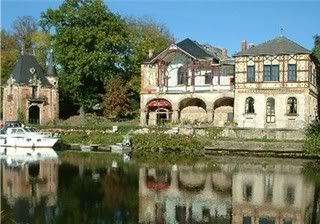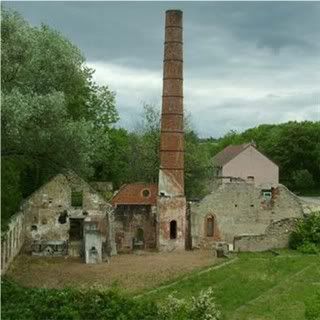|
A Brief History of Sarreguemines Pottery
The Beginning: In 1790, three tobacco merchants founded a pottery in the town
of Sarreguemines (pronounced Sahr-guh-mean) on the left bank of the Sarre River at the confluence of the Sarre and  Blies Rivers in the Lorraine region of France. Inhospitable circumstances forced them to abandon their project after
less than ten years. In 1800, Paul Utzschneider, a young Bavarian, acquired the pottery, and under his inspired leadership,
and that of his son-in-law, Alexandre de Geiger, who assumed management of the company in 1836, the pottery at Sarreguemines
soon took its place amongst the stars in the ceramics world. They were best known for their “faience fine”
(tin-glazed earthenware), lustered ware, jasperware, and stoneware. When Napoleon I commissioned several decorative
pieces for his apartments at Versailles, the reputation of the pottery at Sarreguemines on the world stage was secured. Blies Rivers in the Lorraine region of France. Inhospitable circumstances forced them to abandon their project after
less than ten years. In 1800, Paul Utzschneider, a young Bavarian, acquired the pottery, and under his inspired leadership,
and that of his son-in-law, Alexandre de Geiger, who assumed management of the company in 1836, the pottery at Sarreguemines
soon took its place amongst the stars in the ceramics world. They were best known for their “faience fine”
(tin-glazed earthenware), lustered ware, jasperware, and stoneware. When Napoleon I commissioned several decorative
pieces for his apartments at Versailles, the reputation of the pottery at Sarreguemines on the world stage was secured. A period of growth: Alexandre de Geiger was just as adept and canny a business man as his
father-in-law. Politically active, he served as mayor of the town of Sarreguemines, and later served as Senator of the
Empire, eventually becoming Consul General. His political prowess served the pottery well, as under his influence a
well-developed system of railways and navigable canals enabled the growth of the town of Sarreguemines into a formidable transportation
center, a great advantage to the pottery on the banks of the Sarre. Alexandre’s visionary approach brought modern
industrial techniques and theories to the business, and Alexandre presided over the significant expansion of the pottery.
In 1838, he affiliated the pottery at Sarreguemines with the famous German pottery families of Villeroy & Boch and Mettlach.
Conflict intervenes: In 1870, Otto von Bismarck of Prussia, with his sights
set on eliminating French influence over German states and achieving a “unified Germany”, succeeded in goading
France into hostilities. When the French forces were defeated by a coalition of German states in the 1870 War (Franco-Prussian),
and nearly all the territory of Alsace-Lorraine was taken by Prussia to become part of the German state, Alexandre de Geiger
left Sarreguemines and retired to Paris, ceding control of the pottery to his son, Paul de Geiger, in 1871. Under the harsh
terms of the Treaty of Frankfurt which ended the 1870 War, the residents of Alsace-Lorraine were given the choice to stay
and become German citizens or leave their homes and emigrate to France. In order to enable his workers to retain their French
citizenship and to avoid the high taxes imposed on German imports, Paul de Geiger opened a factory in Digoin in Saone-et-Loire,
France. Soon after, he opened a factory and warehouse in Vitry-le-François in Marne, France to house the productions
from the Sarreguemines factory.  The company recovers: The French public understandably shunned German imports in the
aftermath of their public humiliation at the Treaty of Frankfurt, and as a result Sarreguemines—being under German control—suffered
a significant loss in sales. The factory in Digoin and the storage facility in Vitry enabled the pottery to not only avoid
high taxes on German imports, it also allowed the products to carry a French label, restoring the company’s reputation
amongst its French customers. The company further enhanced their credibility with the French public, when Paul de Geiger’s
daughter married Hippolyte Boulanger, the esteemed director of Choisy-le-Roi. This opened another avenue for Sarreguemines
workers that did not want to become German citizens. Choisy was able to take those that could not be accommodated at the factory
at Digoin. It was about this time (circa 1870-71), that Paul de Geiger introduced a new product line for the company, the
highly decorative, “majolique”, that propelled the already successful company to resounding commercial success. The company recovers: The French public understandably shunned German imports in the
aftermath of their public humiliation at the Treaty of Frankfurt, and as a result Sarreguemines—being under German control—suffered
a significant loss in sales. The factory in Digoin and the storage facility in Vitry enabled the pottery to not only avoid
high taxes on German imports, it also allowed the products to carry a French label, restoring the company’s reputation
amongst its French customers. The company further enhanced their credibility with the French public, when Paul de Geiger’s
daughter married Hippolyte Boulanger, the esteemed director of Choisy-le-Roi. This opened another avenue for Sarreguemines
workers that did not want to become German citizens. Choisy was able to take those that could not be accommodated at the factory
at Digoin. It was about this time (circa 1870-71), that Paul de Geiger introduced a new product line for the company, the
highly decorative, “majolique”, that propelled the already successful company to resounding commercial success.
"Majolique" makes its first appearance: At first, the new product was made using
the old stoneware molds. Paul de Geiger had purchased Arnoux kilns from Minton and installed them in the Digoin facility for
the production of majolica. The public greeted the new and colorful wares with wild enthusiasm and Sarreguemines expanded
the product line to include all manner of tableware, tobacco jars, massive decorative tile panels, monumental vases, pedestals
& jardinières, and stunning works of fantasy, not to mention the renowned “character” jugs. Comparable
to the likes of Minton and Wedgwood in England, or Bernhard Bloch at Eichwald and Wilhelm Schiller at Bodenbach in Austria,
Sarreguemines’ majolica exhibits remarkable attention to detail, deep and crisp modeling, and an exquisitely deft use
of color. Sarreguemines’ rich and deep cobalt blue and ochre became virtual trademark colors for the company, and are
still so recognized today. Another conflict: By the turn of the century, Sarreguemines
had become one of the largest potteries in Europe, employing more than 3,000 workers. Paul de Geiger died in 1913 and the
company was split into two: one, the German concern; the other, the French facilities. At least for a time before World
War I, the Sarreguemines facility was under the management of Max von Jaunez, who was a cousin of Paul de Geiger, while during the
war the German facility at Sarreguemines was under the control of the director of Mettlach, Roger von Boch-Galhau. The end
of World War One saw the restoration of the territory of Alsace-Lorraine to France, and the two companies were reunited under
the three names, Sarreguemines, Digoin, and Vitry-le-François with the Cazal family (another Geiger relative) at the
helm. the Sarreguemines facility was under the management of Max von Jaunez, who was a cousin of Paul de Geiger, while during the
war the German facility at Sarreguemines was under the control of the director of Mettlach, Roger von Boch-Galhau. The end
of World War One saw the restoration of the territory of Alsace-Lorraine to France, and the two companies were reunited under
the three names, Sarreguemines, Digoin, and Vitry-le-François with the Cazal family (another Geiger relative) at the
helm. The beginning of the end: In the 1930’s the popularity of majolica
began to wane, and Sarreguemines started to focus production on other types of pottery. During World War II, the Sarreguemines
factory was sold to Villeroy & Boch of Mettlach, who then transferred ownership to the town. The sale and subsequent transfer
of the property to the town was annulled by the county court in 1946. All production of majolica had ceased by that point.
In 1979 the company was taken over by the Luneville-Badonviller-St. Clement group and by 1983 the factory doors were closed
altogether. St. Clement, now in possession of the old Sarreguemines molds, began to reproduce some of the more popular Sarreguemines
products, mainly consisting of dessert sets, tableware, and some of the Sarreguemines majolica animal pitchers. The old Sarreguemines
facility, including the worker’s dormitories, kilns, the factory, the mill, the casino (not a gambling establishment,
but a recreational facility), and Paul de Geiger’s old residence are now all part of the Sarreguemines Museum. In fact,
there is an outlet store on the grounds of the museum selling the modern reproductions of the classic Sarreguemines pieces!
Return to top of page
Bibliography - Faïences de Sarreguemines: Les Arts de la Table, Emile
Decker & Christian Thévenin, Presses Universitaires de Nancy, Nancy, 1992
- Franco-Prussian WarMicrosoft
Encarta Online Encyclopedia 2008 http://encarta.msn.com © 1997-2008 Microsoft Corporation.
- Majolica Figures,
Helen Cunningham, Schiffer Publishing Ltd., Agden PA, 1997
- Two Centuries of Faience,The Sarreguemines Musuem,
http://www.sarreguemines-museum.com, Sarreguemines Museum, 3 July 2003
- Pichets en Barbotine: Personnages, Animaux,
Fleurs, Maryse Bottero, Editions Charles Massin, Paris, 2000
- Politics of Alsace-Lorraine c. 1870, http://www.mtholyoke.edu/~jihazel/pol116/politics.html,
Julia I. Hazel, December 2001
- Sarreguemines: Les Marques de Fabrique, Sarreguemines Passions, L’imprimerie
Pierron, Sarreguemines, 2005
- Sarreguemines: French Pottery with International Appeal, Collector’s
Café, http://www.collectorcafe.com/index.asp, Mel Lewis, 31 March 2000
- The Regions of Bitche and Sarreguemines,
European Institute of Cultural Routes, http://www.culture-routes.lu/php/fo_index.php?, Caroline Hamadja, 17 July 2007
- Treaty
of Frankfurt (1871), Wikipedia, 23 April 2008, http://en.wikipedia.org/wiki/Main_Page
|
|
|
A Sampling of Antique French Majolica from the Shantique Gallery Shop
|
|
Antique French Majolica Frie Onnaing Milanais Jardiniere I
love the gorgeous jardinieres that Frie-Onnaing came up with at the turn-of-the-century-they just shout Art Nouveau...and
French...to me! This stunning example features a central orchid... See the item |
|
|
Antique French Majolica Art Nouveau Griffin Jardiniere I
am very pleased to offer this magnificent antique French majolica Art Nouveau double handled cache pot which dates to between
1890 and 1914. The main body of the cache pot features a stylized... See the item |
|
|
Antique French Majolica Delphin Massier Thistle Cache Pot
This
was made at the turn of the century by the renowned French artist Delphin Massier. The Massier family of Vallauris, France,
is world famous for their high-quality art pottery and majolica produced first by the father, Jacques... See the item |
|
|
Antique French Majolica Impressionist Garnissage Garniture Set
I
am very pleased to offer this exquisite French majolica garniture, or mantel, set consisting of 2 vases and a jardiniere.
This dates to between 1880 and 1910, and is without a doubt one of the most eye-catching beauties I've run into! The body
of each piece is glazed in... See the item |
|
|
Antique French Majolica Frie Onnaing Lyonnaise Jardiniere Made
by the renowned French faiencerie Frie-Onnaing, this "Lyonnaise" pattern footed jardinière, or cache pot,
features a large Art Nouveau style chrysanthemum (I think) glazed in purple flanked by gracefully curved foliage and buds
glazed in aqua and purple... See the item |
|
|
Antique French Majolica Cobalt Dragons Cache Pot I am very
pleased to offer this gorgeous old French majolica cache pot or jardinière. It is glazed in a very deep cobalt blue
with a warm brown skirt around the bottom. There is a neo-classical motif with scrollwork and flourishes in brilliant green
which are draped with garlands... See the item |
|
|
Antique French Majolica Fives Lille Art Nouveau Jardiniere I
am very pleased to offer this gorgeous jardinière made by the famous French pottery of Gustave de Bruyn at Fives-Lille
in the north of France. The body of this jardinière features small clusters of rosy pink and yellow flowers accented
with stylized twigs and foliage in shades... See the item |
|
|
Antique French Majolica Delphin Massier Flower Cache Pot This
breath-taking jardinière, or cache pot, was made at the turn of the century by the renowned French artist Delphin Massier. This
is one of their beloved figural floral pieces (a mum, I think!) and measures 9" tall and 10" in diameter.
It is signed DELPHIN MASSIER, VALLAURIS, A.M... See the item |
We are a proud member of:
|
|

 Blies Rivers in the Lorraine region of France. Inhospitable circumstances forced them to abandon their project after
less than ten years. In 1800, Paul Utzschneider, a young Bavarian, acquired the pottery, and under his inspired leadership,
and that of his son-in-law, Alexandre de Geiger, who assumed management of the company in 1836, the pottery at Sarreguemines
soon took its place amongst the stars in the ceramics world. They were best known for their “faience fine”
(tin-glazed earthenware), lustered ware, jasperware, and stoneware. When Napoleon I commissioned several decorative
pieces for his apartments at Versailles, the reputation of the pottery at Sarreguemines on the world stage was secured.
Blies Rivers in the Lorraine region of France. Inhospitable circumstances forced them to abandon their project after
less than ten years. In 1800, Paul Utzschneider, a young Bavarian, acquired the pottery, and under his inspired leadership,
and that of his son-in-law, Alexandre de Geiger, who assumed management of the company in 1836, the pottery at Sarreguemines
soon took its place amongst the stars in the ceramics world. They were best known for their “faience fine”
(tin-glazed earthenware), lustered ware, jasperware, and stoneware. When Napoleon I commissioned several decorative
pieces for his apartments at Versailles, the reputation of the pottery at Sarreguemines on the world stage was secured.
 the Sarreguemines facility was under the management of Max von Jaunez, who was a cousin of Paul de Geiger, while during the
war the German facility at Sarreguemines was under the control of the director of Mettlach, Roger von Boch-Galhau. The end
of World War One saw the restoration of the territory of Alsace-Lorraine to France, and the two companies were reunited under
the three names, Sarreguemines, Digoin, and Vitry-le-François with the Cazal family (another Geiger relative) at the
helm.
the Sarreguemines facility was under the management of Max von Jaunez, who was a cousin of Paul de Geiger, while during the
war the German facility at Sarreguemines was under the control of the director of Mettlach, Roger von Boch-Galhau. The end
of World War One saw the restoration of the territory of Alsace-Lorraine to France, and the two companies were reunited under
the three names, Sarreguemines, Digoin, and Vitry-le-François with the Cazal family (another Geiger relative) at the
helm.









